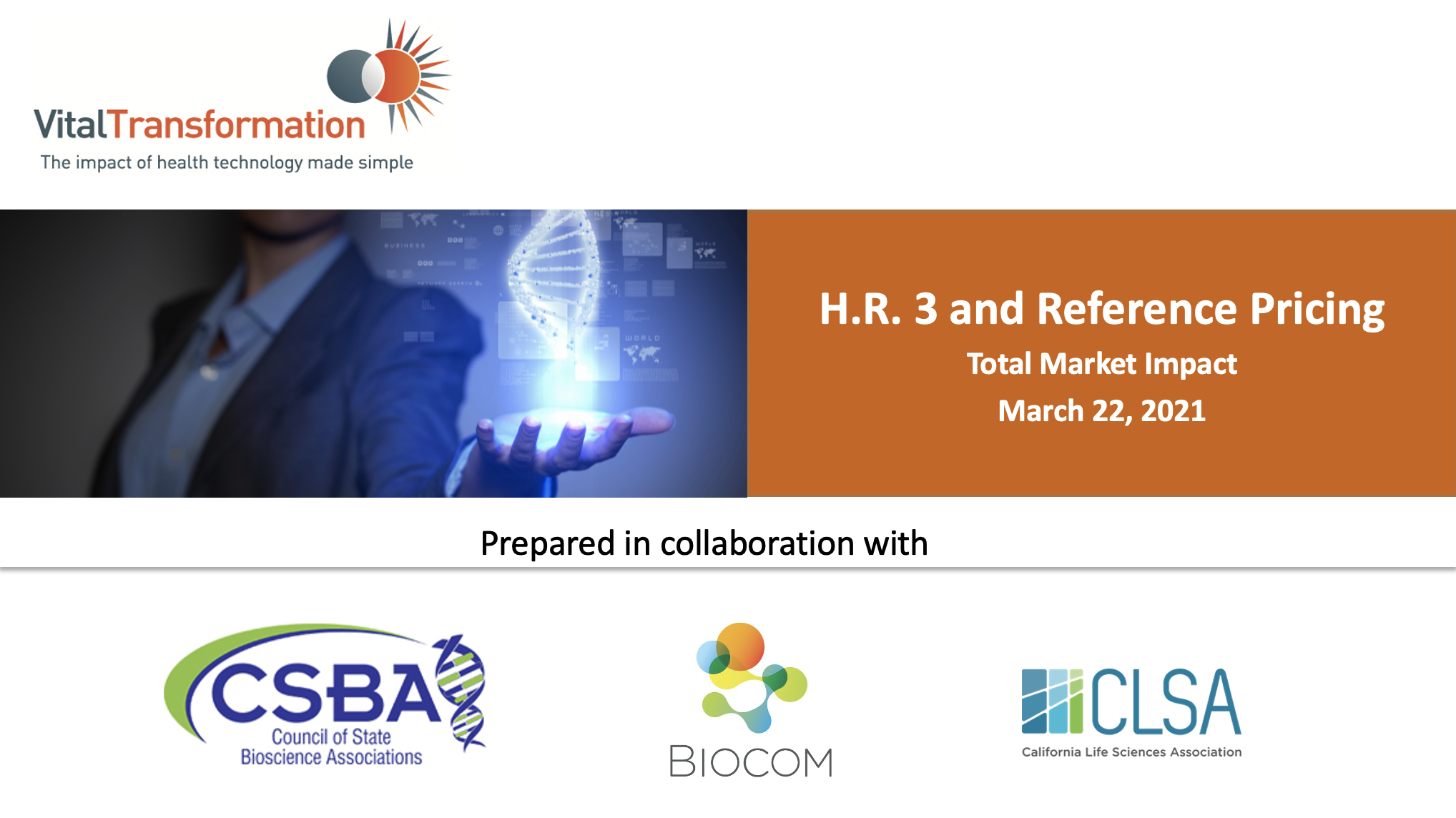H.R. 3 and Reference Pricing. Total Market Impact
The Executive Summary
- Numerous proposals are being considered that would use the average of pricing in other countries to control US drug prices. Proponents argue that this can be done with little impact on innovation.
- Using the Lower Drug Costs Now Act (“H.R. 3”) as an example, we find that implementation of international reference pricing in the United States would:
- Reduce earnings by 62% on average for impacted companies, with one third (32%) of affected companies having reductions larger than 95% of earnings (using conservative assumptions about the impacts on prices).
- In turn, markedly reduce biopharmaceutical companies’ investments in smaller company R&D through M&A, partnerships and other arrangements.
- Reduce by 90%+ the number of medicines developed by small and emerging biotechs — 61 fewer medicines over 10 years.
- Disproportionately impact new treatments in rare diseases, oncology, and neurology.
- Create large investment ecosystem losses to smaller companies in 19 states.
- Eliminate nearly 200,000 biopharmaceutical industry jobs, and nearly 1 million jobs across the economy.
Video
Key Findings
- If enacted, H.R. 3 pricing is projected to:
- reduce US biopharmaceutical industry annual earnings, assuming no defensive measures, from $183 billion to $81 billion in the year 2024 minimum – a reduction of 56%. On average, this is a loss of $102 billion in revenue per year, best case.
- Several companies, many with multiple successful products in H.R. 3, are projected to see revenue reductions larger than their current annual earnings (EBIT), -121%. A third of all affected companies have reductions larger than 95% of net earnings.
- H.R. 3 “penalizes” companies producing the most effective and innovative treatments, many in Oncology, Neurology, Pulmonology and Rheumatology.
- Given its breadth, if enacted, we expect companies will likely avoid developing many Medicare Part D & B therapies altogether, given the punitive H.R. 3 penalties and disincentives.
- It is likely that upwards of $22 billion in revenue from our cohort is being ‘trapped’ by PBMs and not being passed through to patients in terms of savings.
Ecosystem Impacts:
- Over the last 10 years, companies that would be affected by H.R. 3 have invested $487 billion into 215 venture partnerships, the majority in the US, leading to 68 approved therapies (this total removes M&A’s by J&J/Actelion, AbbVie/Allergan, and BMS/Celgene, Pfizer/Wyeth, Merck/Schering-Plough; if included the total is in excess of $700 billion).
- The potential reduction of $100 billion a year in revenue under H.R. 3 is more than twice the annual $48.7 billion a year in partnership investments from 2009 -2019.
- Controlling for all other factors, the revenue reductions under H.R. 3 would be expected to lead to radical US industry consolidation, and shrink market entry of new drugs from the 68 new assets approved during 2009-2019 in our research cohort to 7 under the most optimistic modeling scenarios
- California alone accounts for 25% of total inward & outward investments of $122 Billion into small emerging biotech companies and for 17 of the 68 US drug approvals in our emerging biotech cohort (roughly 25% of the total), it is the largest in the US.
- Under H. R. 3, only 2 of the 16 medicines produced in California from venture partnerships would have come to market, an 88% reduction.
H.R. 3 Methodology
- Current drug prices for included H.R. 3 therapies were obtained with current pricing listed in the WHO National Medicine Price Sources, UK Monthly Index of Medical Specialties, Japan Ministry of Health, Labor and Welfare, Canada Ontario Drug Benefit Formulary, Australia Pharmaceutical Benefits Schemes, Portugal National Authority of Medicines and Health products, France Ministry of Health, Netherlands College voor Zorgverzekeringen, Germany Lauer-Taxe, Denmark MedicinPriser, Sweden Dental and Pharmaceutical Benefits Agency (TLV), and Switzerland Federal Office for Public Health.
- H.R. 3 revenue reductions were modeled at the drug level based upon per dose data obtained from the Medicare Part D & B Drug Spending Dashboard, audited SEC financial statements, and Biomedtracker by Informa.
- GDP, country growth, population/demographic shifts and Purchasing Power Parities were modeled and included within price elasticity calculations to estimate the long-term economic impacts of H.R. 3.
- The investment/partnering activity over the previous 10 years for H.R. 3 impacted companies was measured using the Biocentury IQ Portal, and then statistically reduced based upon the calculated H.R. 3 impact at the firm level.
- The impact of revenue losses caused by H.R. 3 was statistically modeled to determine the revised probability of approved products entering the market from 2009-2019.
Supported by:






